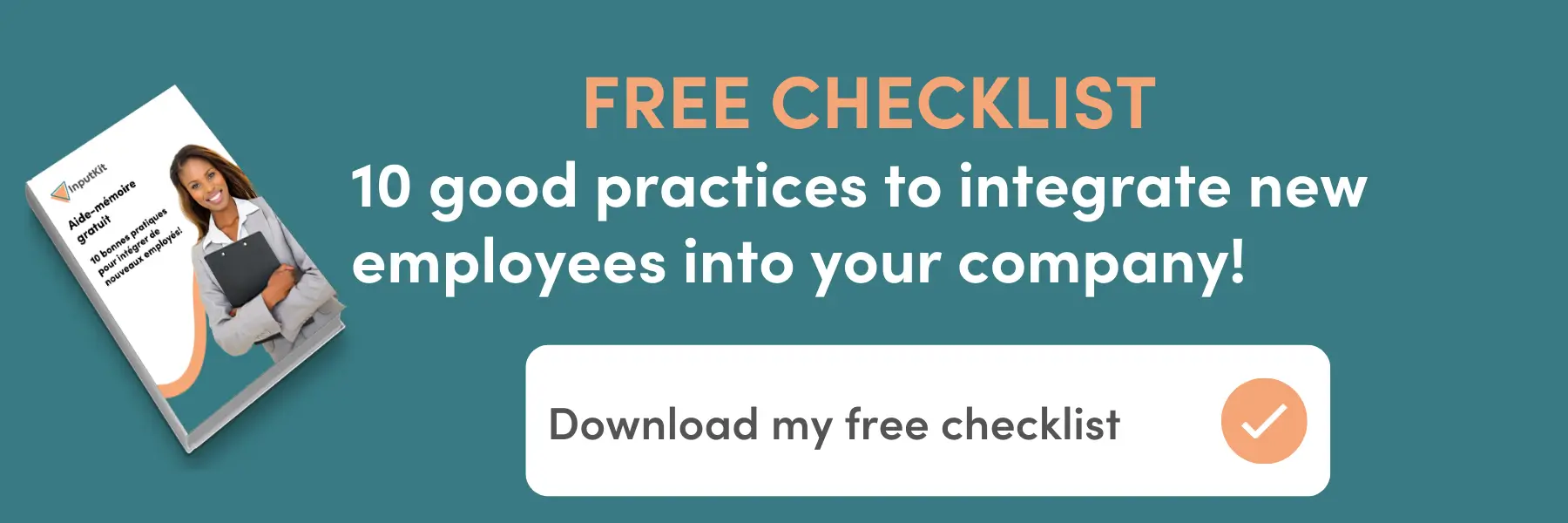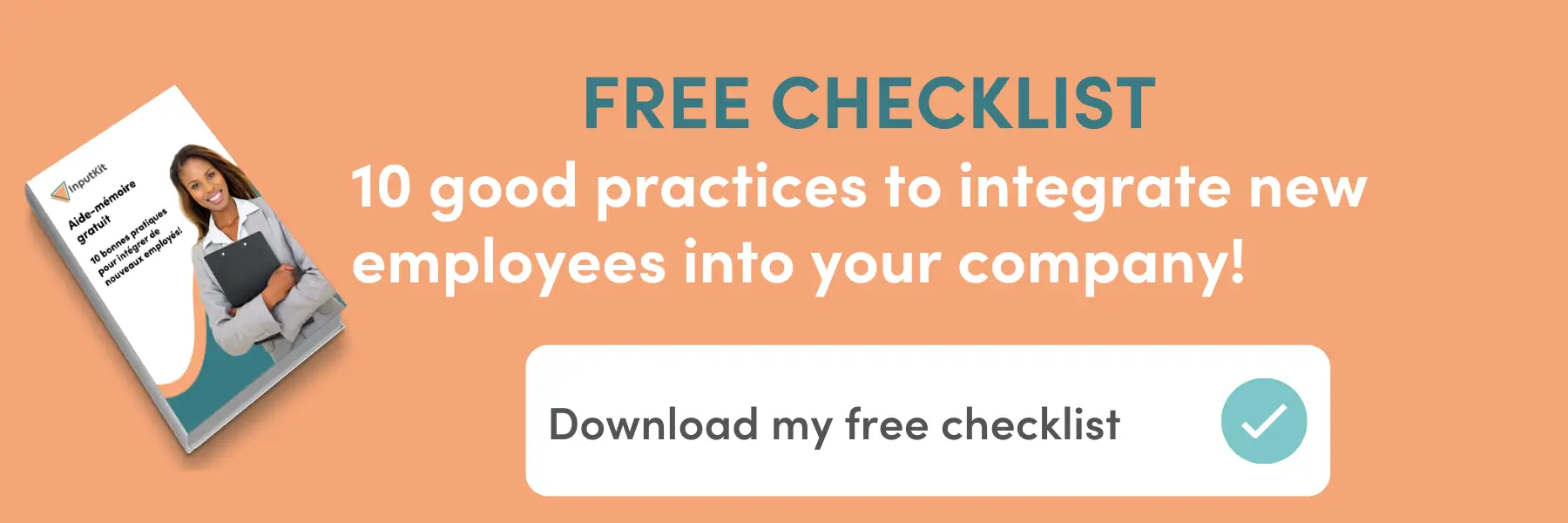There’s no second chance to make a first good impression! In the era of the Great Resignation, employers must make a good first impression on sought-after talent to stand out on the job market. In this sense, it’s very important to make sure that you know how to onboard a new employee to have a flawless onboarding process!
Do you remember your first day at your current job? It’s always a memorable day! However, it doesn’t leave the same impression on everyone. Successful integration into a new team, a warm welcome, and the opportunity to get to know coworkers over dinner can contribute to a new employee’s engagement with the company. Conversely, a disappointing onboarding experience will drive a recruit to seek out other professional opportunities.
Download now: -> FREE CHECKLIST 10 Good Practices to Integrate New Employees into your Company
Do you want to retain the most valuable talents? If so, you must have an optimal onboarding process to effectively integrate new employees. Discover our 7 essentials on how to onboard a new employee and be ready to engage your future talents from the moment they join your team!
How to Onboard a New Employee: the Essentials for a Successful Onboarding!
Are you looking to give your new employees the best chances of success in their new role? If the answer is yes, then knowing how to onboard a new employee is the key to achieving this!
Employee onboarding is an essential process for effectively integrating new employees and providing them with the necessary tools to succeed in their roles. The ability to effectively integrate new employees is essential for retaining talent and ensuring a prosperous future outlook for your company.
Essential #1: Clear and Effective Communication
Communicating clearly and effectively from the beginning of the recruitment process is a key component to knowing how to onboard a new employee into your organization. Keep in touch to stay informed and always be ready to answer their questions. Be careful not to drown them in emails, the objective is to make them feel welcome and know that they can count on you if they need help.
By maintaining open and effective communication with your future employees, you’ll build strong bonds early in the relationship. It shows your new hires that you look forward to welcoming them to your team and gives them the confidence to ask questions and ease into their new role. Such communication will ensure a successful onboarding process for all parties involved!
A best practice on how to onboard a new employee is to provide them with a schedule and plan for their first days of work. This way, your new employee will know what to expect upon arrival and it will make it easier for them to become familiar with your team.
Do you want your recruits to feel comfortable and confident in their new role from their first days? If so, communication is your best ally! It establishes a relationship of trust and openness, gives peace of mind to focus on their role and integrates effectively into the team. Most importantly, it avoids misunderstandings and mistakes that could cause delays and frustration for everyone. Make your new employee feel part of the team before they arrive in your office with clear and open communication!
Essential #2: Provide a Complete and Adapted Training
Initial training is a critical part of the onboarding process of a new employee within a company, which is why it’s essential to plan it carefully before training your recruits. This is an important aspect of successful employee integration! Moreover, it’s a win-win situation for everyone, because a well-trained employee from the start is more likely to perform quickly. In fact, according to the Society for Human Resource Management, managers’ satisfaction increases by 20% when their employees receive standard onboarding training.
To ensure the effectiveness of your internal training program, it’s important to organize it so that it’s well-structured and detailed. To do so, spread it out over several days to allow for progressive and complete assimilation of knowledge.
 Why not designate someone who has common ground with the new hire to assist in their training? Ideally, you should select someone from the same department to work alongside the new employee. This way, a team member will be available to answer questions during the learning process, allowing the recruit to validate their knowledge and ensure they are on the right track. In addition, it facilitates integration and socialization within the team to be paired with a colleague upon arrival at a new position.
Why not designate someone who has common ground with the new hire to assist in their training? Ideally, you should select someone from the same department to work alongside the new employee. This way, a team member will be available to answer questions during the learning process, allowing the recruit to validate their knowledge and ensure they are on the right track. In addition, it facilitates integration and socialization within the team to be paired with a colleague upon arrival at a new position.
Be careful! If designing a person is your way to answer how to onboard a new employee, you need to ensure that this person is fully available for the training. If necessary, lighten the person’s duties so that they aren’t overloaded. This way, they can take the time needed to answer questions and assist the recruit with their training. This way, everyone is comfortable and the training is effective!
Essential #3: Introduction to the Company Culture
Introducing new employees to the company culture is fundamental for a great understanding of how to onboard a new employee! By passing on the company’s values and norms, you allow new employees to adopt your culture and make it shine. This strengthens new hires’ sense of belonging and helps them feel part of the team more quickly. By immersing themselves in your company’s culture, new employees can better understand and learn the company’s codes for quick and effective integration.
Passing on the company’s culture
 Do you want to know how to answer the question of how to onboard a new employee? Passing the company’s culture to new hires is one of the keys! This ensures that all employees are aligned with the company’s values and that they are on the same page. By introducing your company’s standards and expectations, you give your new employees all the keys to quickly becoming familiar with their new work environment.
Do you want to know how to answer the question of how to onboard a new employee? Passing the company’s culture to new hires is one of the keys! This ensures that all employees are aligned with the company’s values and that they are on the same page. By introducing your company’s standards and expectations, you give your new employees all the keys to quickly becoming familiar with their new work environment.
Clearly define the company culture in terms of values and goals. Your mission must be clear to recruits, so make sure to communicate your vision to them so they understand the standards and aspirations of your company. Transform your business into a place where employees are passionate and driven by a shared vision, and your company culture will shine bright!
Fostering a sense of belonging
By taking care to introduce your new employees to your company’s culture, you ensure that they feel included and reinforce their sense of belonging to your team. Quickly become familiar with a new organizational culture makes the adjustment period during a new employee’s onboarding much easier and allows them to quickly become comfortable in their role.
Do you want to master the art of how to onboard a new employee? If so, quickly integrate recruits into your team. Share with them the little traditions of your office! Imagine their smile when they discover that every Friday morning is muffin time for everyone. This will make them feel part of the team and they will look forward to spoiling their colleagues with morning treats!
Essential #4: Building Professional Relationships
Your employees spend an average of 40 hours a week in your office, if not more! Professional relationships contribute to the well-being of your staff. Therefore, good relationships contribute to improving the overall employee experience. Still wondering how to onboard a new employee successfully? Make sure your new employee onboarding process is optimal by introducing recruits to the entire team so they can connect with everyone.
Establishing professional relationships from a new hire’s first few days not only contributes to happiness at work but also facilitates their induction into the team. By feeling comfortable early on, the recruit is more willing to collaborate with colleagues, which fosters team relationships and makes it easier to move projects forward.
To break the ice and create strong bonds, why not organize an informal event for employees to get to know their new colleagues? Whether it’s a team dinner at a restaurant, an impromptu happy hour or an afternoon in the great outdoors, these relaxed moments will allow you to discover your colleagues in a new light and develop common affinities. In this way, you make the onboarding of a new employee an enjoyable experience for everyone!
Essential #5: Progressive Autonomy
This innovative method consists of gradually giving an employee more responsibility during their integration so that they can smoothly adapt to their new work environment. They will learn about the different aspects of their job, ask questions and get advice from their experienced colleagues.
This is a good practice to improve employees’ well-being and job satisfaction. When they can perform their tasks independently, they feel more in control of their work and more able to make important choices. They also feel more accountable for their actions and results, which leads to a sense of accomplishment. Progressive autonomy can also increase commitment and motivation at work, as they know that their contributions are valued and that they are considered an important part of the team.
In short, progressive autonomy is a good answer to the question of how to onboard a new employee, because it lightens the workload of the team that had to fill the vacant position during recruitment. In fact, the more autonomy a recruit gains, the more quickly they will be able to occupy the position and perform tasks independently!
Essential #6: Skills Assessment
The success of new employees is directly related to their onboarding and performance. Evaluate your new hire’s skills a few weeks after their arrival to measure the effectiveness of their onboarding process. It will give you precious insights on how to onboard a new employee successfully to your company and by the same token, improve your onboarding process!
The skills assessment identifies the employee’s strengths and weaknesses as well as opportunities for improvement in their position. It also helps define training and professional development objectives for the employee to ensure that they are ready to meet the challenges of their position.
Assessing the newly acquired skills of recruits is necessary to guarantee the success of new talents in your company. Not only does assessment ensure that employees have the necessary skills they need to perform their jobs effectively, but it also helps increase employee retention by ensuring they feel valued and invested in their work. In addition, by evaluating the onboarding of recent employees, you will be able to target areas for improvement to optimize your onboarding process!
Essential #7: Feedback
Another good thought on how to onboard a new employee is to opt for a winning onboarding process through feedback! It’s an unwavering pillar of motivation, whether it’s building the confidence of your senior employees or celebrating the successes of your new talent.
Feedback is a driver of motivation for employees. Providing constructive feedback frequently can encourage your employees’ professional development. Focusing on their strengths boosts their self-esteem and encourages them to do their best every day while focusing on their weaknesses helps them know where they can improve in their role. In this sense, 69% of employees say they would work harder if their contribution was recognized through feedback, according to Zippia statistics. For these reasons, feedback is a must for a successful onboarding process but also for maintaining optimal performance for your company!
Still wondering why feedback is an important asset on how to onboard a new employee? If so, here’s another argument to convince you: feedback is essential for building strong and healthy relationships in the workplace. Encouraging your employees to give feedback and recognize each other helps to build a sense of belonging to the team! It’s also a way for employees to feel pride and respect for themselves and their work. Employers who provide regular feedback foster a culture of open and respectful communication, thereby strengthening interpersonal bonds. Establish a harmonious and supportive work environment by making feedback a standard practice – demonstrate from the moment a new employee is onboarded that your company culture is focused on growth, support and success!
InputKit: the Tool that Answers the Question of How to Onboard a New Employee
InputKit’s employee experience management platform is the ideal solution to get precious insights on how to onboard a new employee. Whether you want to measure the engagement of your established employees or take the pulse of your new hires’ onboarding, this is an information-rich solution to take your employee experience to the next level!
With customized internal surveys, you’ll get honest, actionable feedback on your employees’ experience. Dynamic reports will allow you to measure the most important metrics, such as:
- Relationship with the manager;
- Recognition at work;
- Personal growth;
- Relationship with colleagues;
- Job satisfaction;
- Well-being;
- And much more!
Optimize your employee experience to retain your best talent with the InputKit solution. Thanks to customizable pulse surveys, you can ensure that your employees are satisfied regularly. The one-time surveys allow you to question your employees at key moments: to follow up on the onboarding of a new employee after three months, to plan a team activity or even to follow up on an exit interview. This feature will allow you to make enlightened decisions based on concrete feedback from your employees.
Plan my free InputKit demo to improve my employee experience
How to onboard a new employee in the best possible way? Follow our best practices and get inspired by our essentials to improve your onboarding process!
First, make sure you communicate clearly and effectively with your new hires. Keeping in touch regularly shows that you are looking forward to the arrival of this recruit and that you are available to them if they have any questions. Make sure the training is adapted and complete to welcome and train your new employees! This way, new talent will become comfortable and perform quickly, leading them to develop progressive autonomy early in their career. Introduce them to your corporate culture so they feel a sense of belonging and build strong relationships with their colleagues. Don’t forget to give them feedback on their work and keep a record of this feedback, it will be very useful during the skills assessment!
Need a hand optimizing your new employee onboarding process? If so, schedule your free personalized demo of the InputKit solution now. Our specialists will be happy to help you improve your new employees’ onboarding and take your employee experience to another level!
Finally, we hope these essentials have answered all your questions on how to onboard a new employee. Don’t hesitate to inspire yourself with our best practices to create a warm onboarding process within your company! As a side note, watch the difference between bad onboarding and good employee onboarding in this video from Ascender HCM :
FREE CHECKLIST
10 Good Practices to Integrate New Employees into your Company



Related articles

Receive our best articles and tips by email
Be the first to know about our new articles.






